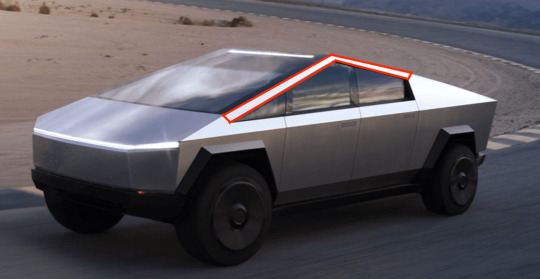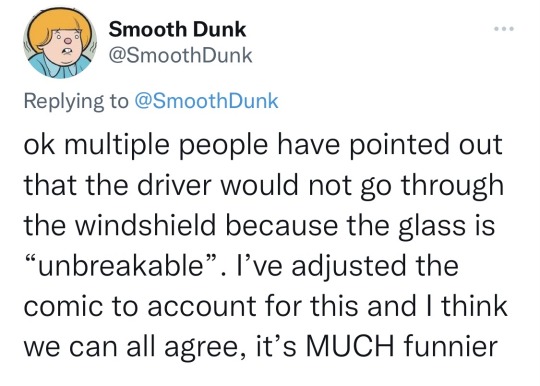#Cybertruck acceleration
Explore tagged Tumblr posts
Text
Tesla's Cybertruck Roars into Action: Limited Deliveries, Jaw-Dropping Performance!
Tesla Cybertruck deliveries began with a few pickups, making them a rare sight on the streets. The Cybertruck’s impressive features include a steer-by-wire system, a 48-volt architecture, and astonishing acceleration in drag races. Tesla Cybertruck deliveries finally began on Thursday at a large celebration. The company only sent a few pickups, so you’re not going to see them all over town this…

View On WordPress
#48-volt architecture#auto news#Cybertruck acceleration#Cybertruck battery technology#Cybertruck deliveries#drag race Cybertruck#drive test Cybertruck#Elon musk#esla Cybertruck#Franz von Holzhausen#handle-less doors#Lars Moravy#NEWS#panel gaps Cybertruck#stainless steel body#steer-by-wire system#Tesla Chief Designer#TESLA CYBERTRUCK#Tesla Cybertruck bulletproof#Tesla Cybertruck design#Tesla Cybertruck development process#tesla cybertruck drive test#Tesla Cybertruck features#Tesla Cybertruck ice conditions#Tesla Cybertruck stiffness#Tesla pickup#Tesla press staff
0 notes
Text
Un Tesla Cybertruck se mea en la cara de un Lamborghini:
63 notes
·
View notes
Text

#not siege engine#Cybertruck#Elon musk#haha l + ratio + bad accelerator#always choose your lube responsibly
4 notes
·
View notes
Text
Only peripherally following the whole cybertruck thing but loving the comments on mkbhd's new short about the mass recall

5 notes
·
View notes
Text
youtube
#political establishment#sales training for consultants#meltdown#tulsi gabbard confirmation hearing#sales training for speakers#sales acceleration formula#sales technologies#sales acceleration#sales training for coaches#tesla cybertruck trump hotel#kash patel#sales training#sales training for thought leaders#b2b sales growth#bill maher asmongold#cybertruck trump hotel#sales training best practices#tulsi gabbard#bill maher cooked them#sales#Youtube
1 note
·
View note
Text

Tesla has recalled all Cybertrucks ever made and delivered in the US over a trim falling off the electric truck, which can be a dangerous hazard if it happens while driving. (March 20th, 2025)
Tesla is recalling ALL 46,000 Cybertrucks, because they "used the wrong glue" to hold their heavy, useless, steel trim panel onto the vehicle. Before this recall, starting two years ago, there have been hundreds of complaints filed about them flying off the vehicle while in motion. I don't even know how this this is allowed to remain on the roads if this piece of steel can fly off at any time:

They are replacing it with a "glue known to not be prone to environmental wear", oh, and also a stud welded to the panel that will be clamped to the trucks structure. You know, what they should have done when it was first made? Adhesive + Heavy Steel is not a particularly great idea in any form.

Their "reasonable" estimate is 1% all Cybertrucks have this issue, but could be up to 10% or more. There are over 200 "official" complaints before this recall.
This is after they had the same issue that caused the accelerator pedal (to make the car go, and speed up) to have its steel top cover slide off, become lodged and stuck, and force the car to go at maximum speed. They fixed that, by the way, by having a single rivet put in place. Which they knew they should have done to begin with.
This isn't even the first time they've been recalled due to their panels falling off, and it won't be the last, as most of their outer panels are supposedly "glued" using the same method and materials or similar as the trim piece above. Not riveted. Not welded. Glued.
If you're driving and see a Cybertruck, make sure to give them a good old "roman salute" (while laughing at them) as a courtesy reminder for their idiocy, and then staying about six hundred feet away. You may just save your life, others, and theirs (if they get rid of it out of total shame).
322 notes
·
View notes
Text
Tesla, a future case study for securities law classes across America, had to stop delivering Cybertrucks this past weekend. No, not because the hundred-thousand–dollar medium-duty pickup, which is only any of those things in the loosest interpretive sense, tends to brick when it gets rained on; nor because its stainless steel panels get all rusty and nasty-looking after weeks exposed to the rare, harsh condition of "being outside." Perhaps you think it has something to do with the shorter-than-advertised driving range and longer-than-advertised charging time, but no: Rather, the cause of this snag is that the trucks struggle with the basics of stopping and going, by which I mean that the accelerator pedal cover slides off and gets stuck under a panel and locks the accelerator pressed down and keeps the Cybertruck stuck at maximum velocity.
Came for the headline, stayed for that opening paragraph.
Hooooly shit that is some damn fine snark. Anyway, Tesla stopped selling them this week because of a fatal flaw in the accelerator pedal. Probably the only reason nobody has died in a Cybertruck yet is that they so often fail to start and/or brick themselves regularly.
295 notes
·
View notes
Text
Definitely funnier. Fortunately we cannot see the INSIDE of the cybertruck after it’s high-speed collision.



Source smoothdunk on twitter
56K notes
·
View notes
Text
Tesla is recalling all 3,878 Cybertrucks that it has shipped to date, due to a problem where the accelerator pedal can get stuck, putting drivers at risk of a crash, according to the National Highway Traffic Safety Administration. The recall caps a tumultuous week for Tesla. The company laid off more than 10% of its workforce on Monday, and lost two of its highest-ranking executives. A few days later, Tesla asked shareholders to re-vote on CEO Elon Musk’s massive compensation package that was struck down by a judge earlier this year.
Continue Reading.
159 notes
·
View notes
Text
According to the National Highway Traffic Safety Administration (NHTSA) on Wednesday, the defect can result in the pedal pad dislodging and becoming trapped in the vehicle’s interior trim when “high force is applied.”
Oh great, so the low-poly murder box that Musk boasted as being able to "win any collision" has an accelertor pedal that can get stuck at full speed. What could go wrong?
119 notes
·
View notes
Text
You know, I may be bad about overlooking the details of a project, but I will never be "Tesla recalls all cybertrucks on market due to faulty accelerator" bad.
104 notes
·
View notes
Text
Earlier this month, Tesla, the Elon Musk-led car company, staged a publicity stunt in front of the White House. A row of electric vehicles, including an angular stainless-steel Cybertruck, was arranged for Donald Trump to inspect before a fleet of news cameras. As far as photo opportunities go, it was absurd enough, turning the supposedly august Presidential residence into something resembling the set of a car-dealership commercial. (In its jarring clash of high-and-low symbolism, it recalled the Four Seasons Total Landscaping press conference that Rudy Giuliani hosted on Trump’s behalf after the 2020 election.) Trump, playing the role of the discerning shopper, stepped into a gleaming red Tesla Model S. Musk circled the car, ready to assist his faux client, and pointed out the brake and the accelerator. “It’s like driving a golf cart,” he said. Trump, presumably admiring the touch screen that the car has in lieu of buttons, exclaimed, “Wow! That’s beautiful. . . . Everything’s computer!”
The event was a transparent attempt to lift Tesla’s stock price, which has suffered recently in large part owing to mounting anti-Musk public sentiment. But it was Trump’s brief utterance that stole the show. He has always had a genius for contagious coinages—even, occasionally, when the language is accidental. (Remember “covfefe”?) “Everything’s computer,” with its compressed and fractured syntax, perfectly evokes the befuddling era we find ourselves in: technology is infiltrating every aspect of our lives—even, with Musk’s DOGE rampage, the workings of the federal government. Tesla is computer; artificial intelligence is computer; politics is computer. Am I computer, too? The phrase instantly became a meme, used to caption everything from clips of “The Matrix” and “Star Wars” to images of Kim Kardashian with a humanoid Tesla robot with which she has lately been staging scenes.
The phrase is enthusiastic yet ambivalent. It can be uttered in delight or in fear. Above all, it expresses a kind of bemusement at the tumultuous unknowability of our moment, and in that respect it has something in common with other memes that have gained traction in the first months of the second Trump Administration. As I observed in a column last year, the 2024 election was characterized online by its brain-rot memes, nonsensical collisions of imagery that produced a lot of noise but little coherent impact. (See, for instance: Kamala Harris and brat summer.) Now the brain rot persists, but the underlying subject matter is more dire. We participate in the memes to express our anxiety that whatever is coming next might be even more chaotic than what is already happening.
Another recent example: “Trump took egg. Egg gone.” That phrase is the work of Michael Sweeney, a video editor in San Diego who sometimes directs Democratic political ads. He’d been to his local Costco, where shoppers were maxing out a store-mandated allotment of eggs: two packages of sixty eggs apiece. Sweeney grabbed one of the last eggs on the shelves and, on February 4th, reposted a picture of bare shelves to the social network Bluesky with the caption in question, which quickly took on a life of its own. Sweeney told me recently, “Unlike a lot of problems in the government that Trump’s incompetence is causing, this one is very easy to point out and self-evidently a problem even to people who don’t pay attention to politics.” The phrase morphed into “Trump Take Egg” and then became a memetic rallying cry across social media, labelling more photos of empty shelves and graphs of rising egg prices. A taqueria in Virginia used it as an excuse for a buy-one-get-one-free deal on breakfast tacos: “Trump take egg. Brazos give egg.”
Democrats have struggled to craft any sort of effective message of opposition to the second Trump Administration. One recent round of video clips featuring the speeches of Democratic senators was roundly mocked for repeating tired talking points. In the absence of anything more galvanizing, the formula “Trump Take _____”—fill in the blank with “egg,” “cancer research,” or “Social Security”—is, as Sweeney put it, “sort of self-consciously stupid but at least feels like you’re landing a punch.” Another favorite target of late is Vice-President J. D. Vance. Vance hadn’t made much of an impression in the new Administration until he helped Trump berate the Ukrainian President, Volodymyr Zelensky, last month in a televised meeting from the Oval Office. Vance sat on a couch, looking something like a petulant child, before practically leaping out of his seat to demand Zelensky “say thank you.” It was Vance’s first breakout public moment as Vice-President, and the meme machine went to work: Vance as Humpty Dumpty; Vance as a toddler with a propeller hat and a lollipop; Vance as a hippie troubadour with a neckbeard and a mop of curly hair. The more bizarre—Vance as the center of a nuclear-bomb explosion—the more apt.
A version of the same Vance meme first took hold last October when the Republican congressman Mike Collins posted an image of Vance that had been heavily edited (“yassified,” in internet slang) to have stronger cheekbones and a more angular jawline. Collins, for unexplained reasons, had turned Vance into a “Chad,” an online archetype of bro-y masculinity. Then a Los Angeles-based creative named Dave McNamee posted an altered portrait of a chubby-faced Vance, promising, “For every 100 likes I will turn JD Vance into a progressively apple cheeked baby.” He went on to create a feminine Vance, an elderly Vance, a Justin Bieber-ish Vance. Collins’s original post, McNamee told me, “revealed a deep insecurity that the right has about J. D. Vance—that he is not the masculine icon they want to prop up.”
Liam Grey, the Canadian administrator of various Instagram meme accounts, including one called @dailyvance, for which he collects memes of Vance’s face, compared the Vice-President to “a modern-day Harambe,” referring to the gorilla that was shot and killed, in 2016, when a human child fell into his zoo enclosure. On social media, people photoshopped Harambe into every imaginable scenario, less out of any animal-rights sentiment than as an early expression of online brain rot, the pursuit of viral content for its own sake: the more meaningless the better. The profusion of memes turned Harambe into a sort of internet folk hero, but Vance is no innocent zoo animal; the images of the Vice-President function more like voodoo dolls, casting vengeful spells from afar.
Zach Silberberg, a digital producer in Manhattan who, last July, created a much-shared meme of Vance with slightly shrunken features, interpreted the popularity of Vance memes as a sign of “people feeling powerless.” The new Administration is dismantling the federal government, allying itself with strongmen, and implementing a new McCarthyism. The Vance memes transmute terror into mockery: as Silberberg put it, “This man has an unprecedented amount of access to power. I’m gonna ruin his day just a little bit.” Earlier this month, the journalist Julio Rosas reported that Vance has seen the memes and “thinks it’s a funny trend.” A few days later, the Vice-President himself posted a Vance meme to his account on X, an edit of his face onto Leonardo DiCaprio’s frame in a scene from the film “Once Upon a Time . . . in Hollywood,” in which DiCaprio’s character, an actor, points at a television screen in recognition. In today’s political ecosystem, any form of internet notoriety might be desirable.
It’s one thing when political memes are brain-rotted; it’s another when the practice of politics itself seems to be. This week, The Atlantic’s editor-in-chief, Jeffrey Goldberg, wrote about being added by mistake to a Signal group chat, titled Houthi PC small group, in which national-security leaders—apparently including Vance; the national-security adviser, Mike Waltz; the deputy White House chief of staff; and the Secretary of Defense, Pete Hegseth, among others—were planning an attack against the Houthis in Yemen. (The White House press secretary denied that war plans were discussed in the chat.) Waltz celebrated the operation’s launch with a fluent string of emojis: 👊🇺🇸🔥. In a display of gallows humor at the sloppiness of the leaders’ theoretically clandestine communication, people online quickly turned those symbols into memes, and renamed their own chats Houthi PC small group. Making war is computer, too.
16 notes
·
View notes
Text
Melissa Ryan at Ctrl Alt Right Delete:
On Saturday, February 15, I was standing outside a Tesla dealership in the heart of Seattle with a sign that said “BigBalls can lick Deez Nuts” and a photo of DOGE dipshit Edward “BigBalls” Coristine. As about 80 of us stood on the street chanting and yelling, an older couple stopped to compliment my sign. They were out for a walk after their breakfast and wondered what the fuss was about. I told them if they wanted to join us, they could hold my sign. To my surprise, they grabbed the sign and spent the next hour happily waving it at passing cars. The key to effective resistance is to make your opponent pay a price for their overreach—or at least instill fear that there might be a price to pay. Clearly, everyone involved in Trump 2.0 believes they can fuck around and will never have to find out. It’s up to us to change that. But how do regular people with limited resources extract a price from a rising fascist movement? The first answer is everything we can think of. No one who’s lived their whole life in the United States has ever faced something like this, and none of us knows for sure what’s going to derail the march toward fascism. In times like these, we should foster creative actions, not wag our fingers or tut-tut ideas.
But there is a very specific target that deserves special focus—Tesla Motors. Tesla is the basis of Elon Musk’s mystique and his wealth. His stake in the company is worth around $145 billion at today’s valuation—more than a third of his total net worth. Elon clearly isn’t scared about the legal consequences of his actions. Why should he be? The courts have never held him accountable in any meaningful way before, and now he’s protected by an increasingly authoritarian regime. But legal consequences aren’t the only cost an effective resistance can make opponents pay. The first thing you need to know is that Tesla Motors is a house of cards. As I write this, Tesla’s market cap stands at $1.12 trillion—about $400 billion more than Toyota, Honda, Ferrari, BMW, Mercedes-Benz, Porsche, Volkswagen, Ford, GM, Stellantis and Hyundai COMBINED. Tesla’s stock has been on a hype-fueled rocket ride since the start of the pandemic. But Wall Street investors hate uncertainty, and in the end, hype is no match for quarterly profits. Most of Tesla’s extreme valuation is based on the cockamamie idea that the company can continue growing at the rate it achieved early in the pandemic—and the mistaken belief that Tesla is a tech company, rather than a car company. But Tesla’s market dominance and opportunities for growth weren’t built to last. Only one in three Americans are open to buying EVs today, and there’s much more competition in the market than there was even 5 years ago. Chinese EV companies are eating Elon’s lunch. And far from the game changer Elon promised, the Cybertruck is looking more like an anchor around Tesla’s neck. Tesla sales are already tanking in Europe because of Musk’s tumbling reputation.
For the first time in a decade, Tesla reported fewer sales in 2024 than in 2023. Now, buyers in the U.S. are starting to price-in Elon’s ties to Trump and far-right movements around the world—and the potential social consequences of driving a car so closely associated with Musk’s personal brand. If that spreads, it could pop the hype bubble. Tesla insiders know it, and so do big Wall Street research firms.
Tesla, the crown jewel of Elon Musk’s empire, has become increasingly persona non grata among the left in the USA, and that is due to Musk’s turn to the far-right that began as early as the COVID pandemic and accelerating further in recent years.
22 notes
·
View notes
Text

This time it’s about a piece of trim that you can rip off by hand (they used glue that gets brittle if exposed to, like, weather), which would be a hazard to other drivers if it came off while the “truck” was moving in traffic. Not as dramatic as the accelerator pedal that could get stuck in the down position, but yet another way in which these ugly, overpriced vehicles are also unsafe and poorly made.
11 notes
·
View notes
Text

Remember Tesla Cybertruck's oversized windshield wiper? The one that appears too large to exist, at least not without malfunctioning in some way? Well, it turns out that it is.
"On affected vehicles, the front windshield wiper motor controller may stop functioning due to electrical overstress to the gate driver component," the recall report says. "A non-functioning windshield wiper may reduce visibility in certain operating conditions, which may increase the risk of a collision."
This is not the Cybertruck's first recall rodeo. The company recalled all of the Cybertrucks it sold in April 2024 due to accelerator pad issues. Unlike many of Tesla's other recalls, which were easily solved with a software update, these Cybertruck recalls required a visit to a service center. All in all, Tesla has issued four Cybertruck recalls since the car went on sale in November of 2023
191 notes
·
View notes
Text
As a matter of public and driver safety, the Cybertruck is an unmitigated disaster. Since the first trucks shipped in November 2023, they have been plagued by complaints and defects. Musk brags about the strength of the truck body, but the stiff and unyielding structure only ensures any accident will be far worse for not having the kind of collapsible frame as every other car on the road.
The death trap design has been the subject of one disastrous news item after another. The cover of the Cybertruck’s acceleration pedal had a defect that caused it to slip off and get stuck, prompting a recall. In his running account of his problems with the vehicle, Rolling Stone writer Miles Klee describes how the truck’s door gashed open a user’s leg and part of the rear fender went flying off for no apparent reason.
The extra thick windshield, meanwhile, creates an infotainment environment free from all distraction — including the sounds of the screaming pedestrians you’re plowing through at the farmer’s market while you watch “Shark Tank” on the oversized screen. Not that the driver is any safer: The windshield guarantees that in the event of an accident, the truck’s passengers will be pulped in the vehicle interior.
All of which begs the question: How are these vehicles street legal in the U.S.?
26 notes
·
View notes